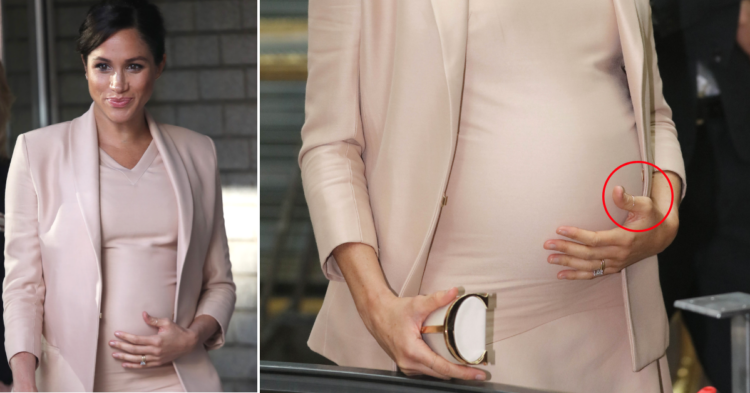I don’t know whose job it is to pore over photos online and hunt for the most minute details to pick apart, but there are clearly some of those detectives working on the royal family’s beat. I don’t think any non-crime scene photos get nearly as dissected and analyzed like the royals’ do.
Mind you, I guess they wouldn’t devote so much time and effort to that if there was nothing to learn from the process. And it turns out, one minute detail in some pics of one of the most photographed people on the planet might have turned up something interesting.
Sleuths poring over pictures of Meghan, Duchess of Sussex, during a visit to the National Theatre in London noticed something that they think could affect her pregnancy: A bendy thumb.

It seems like an odd detail to seize upon, but experts say that bendy digits could be a sign of hypermobility, a condition that could help or possibly hinder her labor.
Hypermobility, sometimes known as double-jointedness, allows people to move their limbs beyond the normal restrictions of their joints.

That makes things like yoga easier for them, and Meghan is reportedly a regular practitioner of yoga. But in pregnancy, hypermobility can be both a blessing and a curse.
In the good news category, hypermobility can help the actual labor go quickly and easily.

“The ligaments of the pelvis, which help hold the pelvis together, are believed to loosen over pregnancy,” Dr. Adam Taylor told The Sun .
“So any more mobility within these from having hypermobility may help make delivery easier too.”

That sounds like something positive, doesn’t it? Less restriction from the pelvis + smoother deliver = happy Meghan.
But, as always, there’s a catch.
As pregnancy progresses, women tend to get more flexible regardless thanks to the hormones relaxin and progesterone.

As birth coach Alexandra Kremer told The Sun , “Relaxin and progesterone are the two hormones that help the ligaments to relax during pregnancy in order to help open the pelvis and allow baby to descend easily.”
The Duchess and former Suits star is believed to be seven or eight months pregnant, so those hormones would be well at work for her.
But hypermobility also brings some concerns with it for pregnant women. They’re not awful, but they could make things fairly unpleasant for Meghan, if her bendy thumb means what the experts think it means.
Pain levels can be worse, especially pelvic and spinal pain, and along with easy labor comes the possibility of early labor.
“It’s not uncommon to have issues with pelvic girdle pain and in more extreme cases it could cause premature labour,” Alexandra says.
“Due to how fragile the connective tissue can be, hypermobility has shown that there can be a connection with early labor.”
Premature babies are at a higher risk of long-term health issues including intellectual disabilities and cerebral palsy, among others.
Luckily for Meghan, approximately 8% of children in the UK are born prematurely — so it’s nothing new to the doctors.

There are also methods to push the delivery and avoid an early birth.
But the worries don’t stop there for Meghan, unfortunately.
Hypermobility is also connected with things like reduced effects of painkillers and anaesthetics.

So, if the labor should require an epidural, it might have little, if any, effect on Meghan’s pain levels. And if she needs an episiotomy or gets a tear, it’s likely to take longer to heal, according to the Hypermobility Syndromes Association .
In addition to these major issues related to hypermobility births, professionals also warn pregnant women about issues they may face as nursing mothers.
One thing the Duchess needs to be wary about is her impending exhaustion while nursing and caring for her baby, according to Hypermobility.org .
As a baseline, new mothers are already tired beyond comprehension, however hypermobile women seem to have it worse than the rest.

Hopefully with the help of the royal family’s Medical House staff, Meghan will be able to rest up enough to manage her exhaustion.
Another problem Meghan may face is the need for rigorous post-natal exercises.

While some mothers can get away with minimal care after giving birth, hypermobile women are required to pay special attention to pelvic floor exercises.
Failure to perform these exercises could eventually lead to various issues later in life — including a uterine collapse.
At the end of the day, though, Meghan is likely being assessed and cared for very well by the royal family’s medical team, and should be in good hands.
h/t The Sun

















































